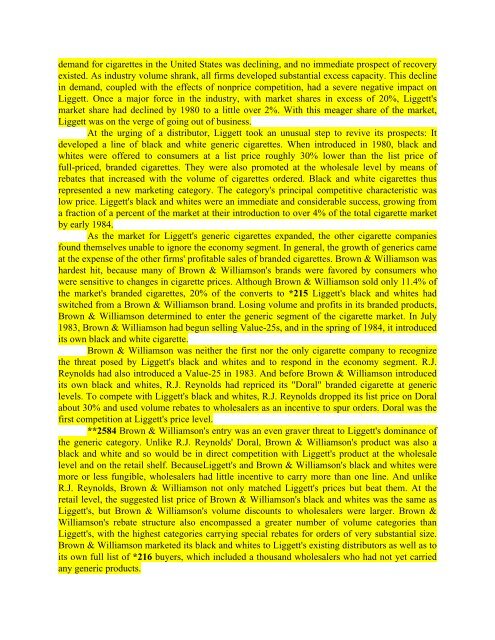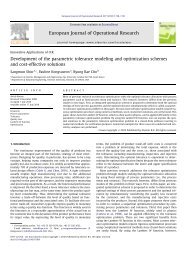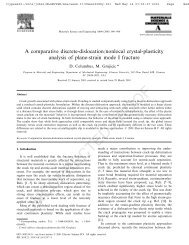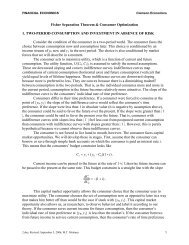509 U.S. 209, 113 S.Ct. 2578 BROOKE GROUP LTD., Petitioner v ...
509 U.S. 209, 113 S.Ct. 2578 BROOKE GROUP LTD., Petitioner v ...
509 U.S. 209, 113 S.Ct. 2578 BROOKE GROUP LTD., Petitioner v ...
You also want an ePaper? Increase the reach of your titles
YUMPU automatically turns print PDFs into web optimized ePapers that Google loves.
demand for cigarettes in the United States was declining, and no immediate prospect of recovery<br />
existed. As industry volume shrank, all firms developed substantial excess capacity. This decline<br />
in demand, coupled with the effects of nonprice competition, had a severe negative impact on<br />
Liggett. Once a major force in the industry, with market shares in excess of 20%, Liggett's<br />
market share had declined by 1980 to a little over 2%. With this meager share of the market,<br />
Liggett was on the verge of going out of business.<br />
At the urging of a distributor, Liggett took an unusual step to revive its prospects: It<br />
developed a line of black and white generic cigarettes. When introduced in 1980, black and<br />
whites were offered to consumers at a list price roughly 30% lower than the list price of<br />
full-priced, branded cigarettes. They were also promoted at the wholesale level by means of<br />
rebates that increased with the volume of cigarettes ordered. Black and white cigarettes thus<br />
represented a new marketing category. The category's principal competitive characteristic was<br />
low price. Liggett's black and whites were an immediate and considerable success, growing from<br />
a fraction of a percent of the market at their introduction to over 4% of the total cigarette market<br />
by early 1984.<br />
As the market for Liggett's generic cigarettes expanded, the other cigarette companies<br />
found themselves unable to ignore the economy segment. In general, the growth of generics came<br />
at the expense of the other firms' profitable sales of branded cigarettes. Brown & Williamson was<br />
hardest hit, because many of Brown & Williamson's brands were favored by consumers who<br />
were sensitive to changes in cigarette prices. Although Brown & Williamson sold only 11.4% of<br />
the market's branded cigarettes, 20% of the converts to *215 Liggett's black and whites had<br />
switched from a Brown & Williamson brand. Losing volume and profits in its branded products,<br />
Brown & Williamson determined to enter the generic segment of the cigarette market. In July<br />
1983, Brown & Williamson had begun selling Value-25s, and in the spring of 1984, it introduced<br />
its own black and white cigarette.<br />
Brown & Williamson was neither the first nor the only cigarette company to recognize<br />
the threat posed by Liggett's black and whites and to respond in the economy segment. R.J.<br />
Reynolds had also introduced a Value-25 in 1983. And before Brown & Williamson introduced<br />
its own black and whites, R.J. Reynolds had repriced its "Doral" branded cigarette at generic<br />
levels. To compete with Liggett's black and whites, R.J. Reynolds dropped its list price on Doral<br />
about 30% and used volume rebates to wholesalers as an incentive to spur orders. Doral was the<br />
first competition at Liggett's price level.<br />
**2584 Brown & Williamson's entry was an even graver threat to Liggett's dominance of<br />
the generic category. Unlike R.J. Reynolds' Doral, Brown & Williamson's product was also a<br />
black and white and so would be in direct competition with Liggett's product at the wholesale<br />
level and on the retail shelf. BecauseLiggett's and Brown & Williamson's black and whites were<br />
more or less fungible, wholesalers had little incentive to carry more than one line. And unlike<br />
R.J. Reynolds, Brown & Williamson not only matched Liggett's prices but beat them. At the<br />
retail level, the suggested list price of Brown & Williamson's black and whites was the same as<br />
Liggett's, but Brown & Williamson's volume discounts to wholesalers were larger. Brown &<br />
Williamson's rebate structure also encompassed a greater number of volume categories than<br />
Liggett's, with the highest categories carrying special rebates for orders of very substantial size.<br />
Brown & Williamson marketed its black and whites to Liggett's existing distributors as well as to<br />
its own full list of *216 buyers, which included a thousand wholesalers who had not yet carried<br />
any generic products.
















